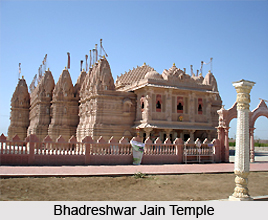 The monuments of Bhadreshwar in Gujarat are of great historical importance. Not only do they mark the site of an ancient Muslim community but also mark a very important pilgrimage site for the Jains in India. The ancient town and seaport of Bhadreshwar is situated about 20 miles from Kandla port in Kutch, Gujarat. Originally the place was known as Bhadravati which in 449 BC was under the rule of King Sidhsen. He went on to greatly renovate the place. Later, the place came under the rule of the Jain Solankis who renamed the place as Bhadreshwar. In 1315 AD a great famine struck the region following which the place was renovated and rebuilt by Jagadusha.
The monuments of Bhadreshwar in Gujarat are of great historical importance. Not only do they mark the site of an ancient Muslim community but also mark a very important pilgrimage site for the Jains in India. The ancient town and seaport of Bhadreshwar is situated about 20 miles from Kandla port in Kutch, Gujarat. Originally the place was known as Bhadravati which in 449 BC was under the rule of King Sidhsen. He went on to greatly renovate the place. Later, the place came under the rule of the Jain Solankis who renamed the place as Bhadreshwar. In 1315 AD a great famine struck the region following which the place was renovated and rebuilt by Jagadusha.
Monuments of Bhadreshwar are of importance mainly for their religious interpretations. There are found here a number of Jain temples built by followers in all of Kutch. Of them all, one of the most important sites of Jain pilgrimage is the Bhadreshwar Jain temple. The Jain temple places considerable importance on the act of pilgrimage, which makes Bhadreshwar a very popular site.
The temple is extremely beautiful. It has been constructed in white marble and has tall majestic pillars holding it up. The entire temple complex extends over an area of about 85 feet by 48 feet. The temple comprises of a sanctum, the Gudhamandapa, Mukhmandapa and the Rangamandapa. The main entrance is from the north. On first entering the temple there is a lobby which has a domical roof. To reach this, there are two stairways, two on each side. Around the central pillar are a total of 52 small shrines. One of these shrines is reputed to hold the original Parshvanatha idol from 500 BC. Being a very old temple, it has been renovated time and time again.
It is believed that in the thirteenth century, Jagadu made a number of improvisations in the temple. He built three devakulikas and an astapada in marble, donated a gold pitcher and staff, installed 172 marble images of Jinnas and adorned the entire image of Parsvanatha with gold plates. Also found here are the ruins of an ancient temple dedicated to Lord Shiva and the remains of an ancient township called the Bhadravati Nagari.
Located near the village of Jalvana, Koday Jinalaya is another holy site for the Jain pilgrims. There are a total of 72 statues of Jain Gods found here. The chief idol here is that of Prabhu Aadeswarji. The divine statue of the Prabhu is a tall one, nearly 73 inches. Though a major attraction of the place is pilgrimage for the Jains, evidences of Muslim dominance can also be seen at this place. There are certain Kufic inscriptions on the epitaphs and remains of a mosque and tomb dating back to the twelfth century. Found here is one of the earliest known instances of Muslim rule.
There are two mosques found in Bhadreshwar, both of which date back to the mid-twelfth century. This indicates that they go beyond the known Indo-Islamic architecture found at Ahmedabad, possibly the first known mosques built in India. The constructions on the mosque are less elaborate than seen in other Islamic constructions. This might mean that Iranian traders arrived by sea and entered Gujarat much before Islam swept across the country starting from Delhi. Consequently, they are more sober, stark and austere without the intricate and flowery embellishments of the later period.
The most important site of Muslim worship here is the Solah Khambi Masjid. This is the only known surviving Muslim structure from the period prior to the Muslim conquest which retains almost all its original features intact.
The high point in the history of Bhadreshwar was reached under Suraj Mai. He built a fort at Bhadreshwar which appears to be a well planned out construction as in is almost impregnable. It has massive double ramparts of mud and rubble surrounded by a wide moat 150 feet wide and 59 feet deep, with a secondary inner moat around the central palace. The outer ramparts are now largely demolished. On the inner ramparts are several gates. Thejawarhar Burj, from which there is a fine view, was built to mark Suraj Mai`s victory over the Mughals. Fateh Burj commemorates the defeat of the British in 1703. The gateway over the moat has huge round bastions with war elephants painted on the stone portals.
There are three palaces found east to west from the moat. These are the Raja`s palace, the Old Palace built in 1733 by Badan Singh and the Kamra Palace. To the North of the Kamra Palace lies the jewel office and court of justice.
In 1803 Lord Lake was repulsed from here with severe losses - over 3,000 men, the most disastrous setback in his illustrious career. In 1825 Lord Combermere attacked the fort from the north-east side and successfully captured the position after a month`s siege.
These are, therefore, the chief monuments of Bhadreshwar. The history of the region is significant for the insight it provides into the earliest traces of Muslim architectural construction.



















